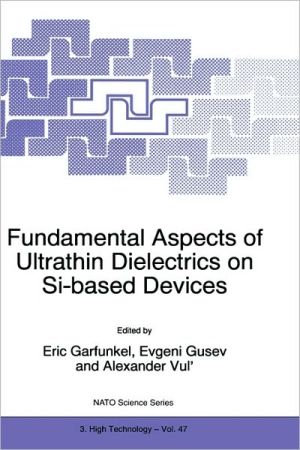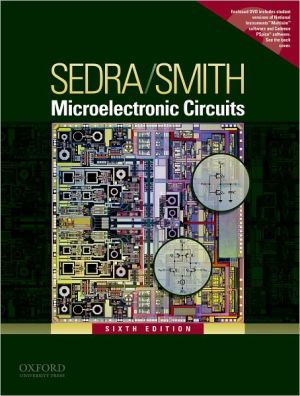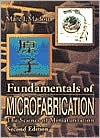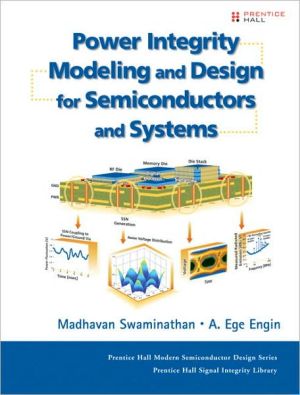Fundamental Aspects of Ultrathin Dielectrics on Si-Based Devices: Proceedings of the Nato Advanced Research Workshop on Fundamental Aspects of Ultrathin Dielectrics on Si-Based Devices Towards An Atomic Scale Understanding, St. Petersburg, Russia, August
An extrapolation of ULSI scaling trends indicates that minimum feature sizes below 0.1 mu and gate thicknesses of Audience: Both expert scientists and engineers who wish to keep up with cutting edge research, and new students who wish to learn more about the exciting basic research issues relevant to next-generation device technology.
Search in google:
An extrapolation of ULSI scaling trends indicates that minimum feature sizes below 0.1 mu and gate thicknesses of <3 nm will be required in the near future. Given the importance of ultrathin gate dielectrics, well-focused basic scientific research and aggressive development programs must continue on the silicon oxide, oxynitride, and high K materials on silicon systems, especially in the critical, ultrathin 1-3 nm regime. The main thrust of the present book is a review, at the nano and atomic scale, the complex scientific issues related to the use of ultrathin dielectrics in next-generation Si-based devices. The contributing authors are leading scientists, drawn from academic, industrial and government laboratories throughout the world, and representing such backgrounds as basic and applied physics, chemistry, electrical engineering, surface science, and materials science. Audience: Both expert scientists and engineers who wish to keep up with cutting edge research, and new students who wish to learn more about the exciting basic research issues relevant to next-generation device technology. Booknews Papers from an August 1997 workshop report on recent progress on the atomic-scale physical, chemical, and electrical understanding of ultrathin dielectric films on silicon-based materials, and identify directions for future basic research in the field. Material is divided into sections on experimental studies of SiO2 films on Si, the theory of SiO2/Si and SiOxNy/Si systems, growth mechanism and analysis of (oxy)nitridation, initial oxidation and surface science issues, microscopic models of defects, new substrates and SOI technologies, and hydrogen/deuterium issues. No index. Annotation c. by Book News, Inc., Portland, Or.
PrefaceIntroductionUltrathin dielectrics in silicon microelectronics - an overview1Study of the Si/SiO[subscript 2] interface using positrons: present status and prospects25Medium energy ion scattering studies of silicon oxidation and oxynitridation39Synchrotron and conventional photoemission studies of oxides and N[subscript 2]O oxynitrides49Stress in the SiO[subscript 2]/Si structures formed by thermal oxidation65Modeling the oxide and the oxidation process: can silicon oxidation be solved?79Core-level shifts in Si(001)-SiO[subscript 2] systems: the value of first-principle investigations89A simple model of the chemical nature of bonds at the Si-SiO[subscript 2] interface and its influence on the electronic properties of MOS devices103Chemical perspectives on growth and properties of ultrathin SiO[subscript 2] layers117A theoretical model of the Si/SiO[subscript 2] interface131Spatially-selective incorporation of bonded-nitrogen into ultra-thin gate dielectrics by low-temperature plasma-assisted processing147Isotopic labeling studies of oxynitridation in nitric oxide (NO) of Si and SiO[subscript 2]165Thermal routes to ultrathin oxynitrides181Nitrogen in ultra thin dielectrics191Endurance of EEPROM-cells using ultrathin NO and NH[subscript 3] nitrided tunnel oxides217Effects of the surface deposition of nitrogen on the oxidation of silicon227Surface, interface and valence band of ultra-thin silicon oxides241Low temperature ultrathin dielectrics on silicon and silicon carbide surfaces: from the atomic scale to interface formation257Interaction of O[subscript 2] and N[subscript 2]O with Si during the early stages of oxide formation277Scanning tunneling microscopy on oxide and oxynitride formation, growth and etching of Si surfaces289The interaction of oxygen with Si(100) in the vicinity of the oxide nucleation threshold309Tunneling transport and reliability evaluation in extremely thin gate oxides315Electrical defects at the SiO[subscript 2]/Si interface studied by EPR325Towards atomic scale understanding of defects and traps in oxide/nitride/oxide and oxynitride systems335A new model of photoelectric phenomena in MOS structures: outline and applications343Point defect generation during Si oxidation and oxynitridation359Optically induced switching in bistable structures: heavily doped n[superscript +] - polysilicon - tunnel oxide layer - n - silicon375Heterojunction Al/SiO[subscript 2]/n-Si device as an Auger transistor383Radiation induced behavior in MOS devices391Hydrogenous species and charge defects in the Si-SiO[subscript 2] system397The role of hydrogen in the formation, reactivity and stability of silicon (oxy)nitride films411Hydrogen-induced donor states in the MOS-system: hole traps, slow states and interface states425Future trends in SiC-based microelectronic devices431The initial phases of SiC-SiO[subscript 2] interface formation by low-temperature (300[actual symbol not reproducible]C) remote plasma-assisted oxidation of Si and C faces on flat and vicinal 6H SiC447Challenges in the oxidation of strained SiGe layers461The current status and future trends of SIMOX/SOI, new technological applications of the SiC/SOI system477Local tunnel emission assisted by inclusions contained in buried oxides493AppendixAuthors index503List of workshop participants505








